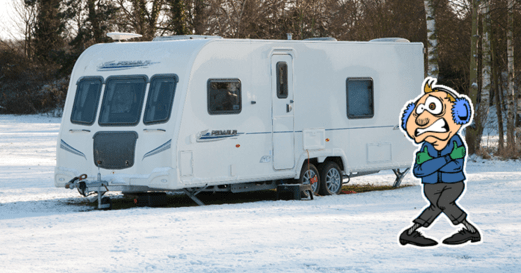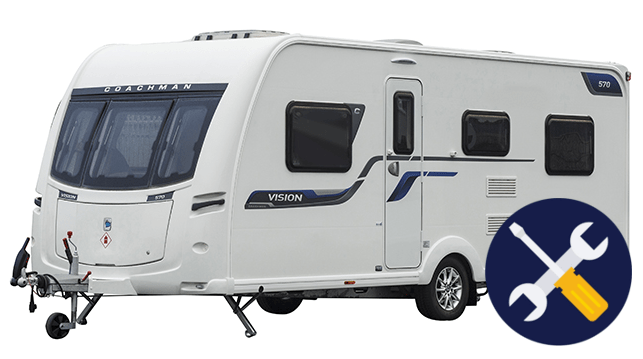
If you’re not into winter caravanning its very important that you properly prepare your caravan for being sat idle during the winter months. I’ve previously written a post on caravan winter storage tips. That post goes through the actual process of draining down the water system etc. I wanted to write this post as a final checklist for your caravan once all those jobs are completed. In other words, just before you walk away from your caravan for several months over winter these final checks can pay dividends. Not only to make sure that your caravan keeps in good condition over the winter months. But you may spot issues/make notes on things you want to fix before you want to use the caravan again next spring/summer.

The cold, wet winter months can be a pretty tough time for your caravan. You want it to be ready to deal with the freezing conditions so nothing breaks.
You also don’t want various creatures getting into your caravan and using it as a winter shelter.
If your caravan is stored on your drive over winter you will be able to keep an eye on it. However, if you have to keep your caravan in a storage yard over winter, that’s obviously more difficult.
So below, is a checklist of things you should have done before you see your caravan again next spring.
Disclaimer: Hey! By the way… any links on this page that lead to products on Amazon or Caravan Guard are affiliate links, and I earn a commission if you make a purchase, with no additional cost to you 🙂
- Dissolves waste and removes odours naturally and has delightful mild fragrance
Want To Visit Horton Common? – Book Here
Table of Contents
Caravan Winter Checklist – Top Five Final Checks
Below I’ve written a top-five final checklist before you leave your caravan to cope with the long cold winter days and nights.
However, where possible, I like to add and share content produced by other caravanners.
As such the video below by Dan of Meet the Trudigans goes through his caravan winter checks in which he discusses many of the points I want to make. So its worth a watch.
1. Inspect The Bodywork/Seals On The Caravan
Obviously, during winter your caravan is going to have to put up with a lot of rain and snow etc. You obviously don’t want any of that moisture getting inside the caravan.
Therefore do a thorough visual inspection of the seals around the caravan. This includes around the windows, vents and lockers.
If you notice that there are any gaps in the sealant/mastic get that sorted as soon as possible before the winter weather takes hold.
Don’t be tempted to just grab a tube of bathroom silicone, it won’t last. You want to get hold of some approved caravan adhesive sealant.
First, clean away all the old adhesive, and clean the surface thoroughly. That way, your repair will last much longer and protect your caravan from water ingress/damp problems.
You want to pay special attention to the seals around vents, TV aerial and roof lights on the caravan roof. Ideally, first, clean the roof so you can properly view the condition of the seals.

Make sure you fix any damaged caravan mastic with a suitable adhesive sealant such as this Sikaflex 512: Image – Amazon.co.uk
2. Check Caravans Windows & Lockers
Next, you want to check that all of the window and exterior lockers on the caravan are properly closed and fixed into position.
Caravan window latches/handles are notoriously flimsy and are known to snap pretty easily. Hence, if any of your window handles do need replacing, swap them ASAP.
Over the winter months, due to higher wind speeds, the window could lift open if both latches are not fixed in position. Then rain/snow may get into the caravan and maybe even some unwanted guests.
Dan, in the video above, also makes sure to put the caps on the waste pipes, which is also not a bad idea to stop various bugs/insects crawling inside.
However, remember to leave your taps open inside the caravan just in case there is still any water trapped inside the pipework.
That way, if that water froze, it wouldn’t pressure the pipework, potentially damaging it.
3. Check your Caravan Tyre Pressures
I’ve written posts in the past on the importance of having the right pressure in your caravan tyres while towing.
However, its also important to have the tyres properly inflated while your caravan is left idle over the winter months.
If the tyres are underinflated, the weight of the caravan will more easily create flat spots on the tyres and also accelerate tyre wall cracking.
Now, in my post on how long to caravan tyres last, I discuss that really, even following all the best tips, they should be changed every five years.
However, if you don’t follow the best industry advice, they may need to be replaced even more frequently.
As previously discussed in my posts, consider tyre savers or moving the caravan/rotating the tyres a couple of times over winter.
In the video above, Dan uses a digital pressure gauge. In my post on caravan tyre pressure gauges, I discuss the pros and cons of such devices.
Whichever tyre pressure gauge you choose, you need to make sure it can accurately read above 60 PSI. I also know some of our guests actually jack up the caravan and remove the caravan wheels over winter.

Whether you use an analogue or digital pressure gauge to check your caravan tyres before winter, make sure it can read up to 100PSI: Image – Amazon.co.uk
4. Empty The Caravan Lockers & Leave Them Open
So as you can see in the video above, Dan empties out all of the contents of his lockers into the centre of the caravan and leaves the lockers open.
He’s doing this so that all the contents of the caravan and storage areas are ventilated over the winter months.
Now, in an ideal world, you would empty out the contents of your caravan, even the cushions and store them in your home over winter.
However, the reality is very few people have the free space to do such a thing.
Dan has also placed a couple of passive dehumidifiers around the caravan to absorb any excess moisture from the air. They are regarded as passive as they don’t use any energy input.
Humidifiers which are commonly used in homes and are plugged in are active humidifiers.
There is an ongoing debate within the caravanning community if using dehumidifiers over winter is a good idea. Some argue that they actually encourage more moist air into the caravan.
Personally, I can see the arguments for and against them, but I think the light use of a dehumidifier in a caravan is a good idea over winter.
Ideally though, overwinter at least once you want to go around the caravan with a moisture meter to spot any issues early on.

These ‘Damp Traps’ are used by Dan in the video above to reduce the humidity within his caravan over winter. They contain a desiccant which pulls the moisture out the air: Image – Amazon.co.uk
5. Leisure Battery Care Over Winter Is Important
In the video above, you can see Dan’s portable solar panel, which he uses to keep his leisure battery topped up over winter.
If you don’t have a permanent solar panel on your caravan, these are excellent to keep the battery healthy over winter in a storage yard.
If you keep your caravan on your drive at home, plug the caravan into the mains every month or so during winter. Alternatively, take out the leisure battery and use a portable leisure battery charger.
Whichever option seems best for you is the right one, but you need to choose one of them.
If you don’t keep your leisure battery charged up over winter, its likely that come spring, it may be kaput.
A leisure battery left at a low state of charge, especially in cold conditions, can be permanently damaged.
But if the leisure battery is being trickle charged, it can cope with freezing conditions. I’ve written a post on how to connect up to your home’s mains supply.

Proper leisure battery care over the cold winter months is very important. Otherwise, your leisure battery may experience permanent damage and loss of capacity: Image – Amazon.co.uk
Book Your Annual Caravan Service
Now, I’ve included this within the winter checklist, as most of our guests and caravanners, in general, will have their caravan serviced during the winter months.
It makes perfect sense, really, why have a service during the spring and summer when it may interfere with your holiday?
However, the reality is if you are going to have your caravan serviced during winter, it needs to be booked several months in advance.
I know of a service centre which one of our guests use where you have to book a year in advance to get a winter service slot.
In either case, if you’re not able to get your caravan serviced in the coming winter, book it in for next winter as soon as possible.
I do have some guests who service their own caravan brakes etc. However, really if you are not completely confident in what you’re doing, leave it to the professionals.

Conclusions On Final Caravan Checks Before Winter Hits
Again, just a reminder, the above checklist is not every job you want to carry out on your caravan before winter hits. For more caravan winter-proofing, please read my post on caravan winter storage.
You may also want to carry out a final clean of the caravan before winter sets in. A good cleaning before winter can often make your spring clean much easier.
I close Horton Common over the winter months between October 31st and March 1st.
However, when spring rolls around again, I hope you consider coming to visit us to experience our expansive views over the Staffordshire Moorlands and Peak District National Park. Thanks for reading. 🙂
Want To Visit Horton Common? – Book Here


